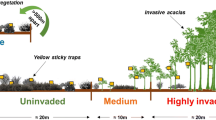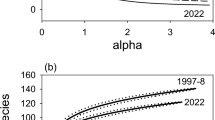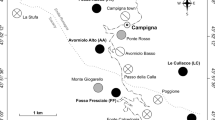Abstract
We compared the arthropod fauna of Rosa rugosa patches to the adjacent native yellow dune vegetation by pitfall trapping in the National Park Thy at the Danish North Sea coast. R. rugosa changes the vegetation from a dune grassland (dominated by Ammophila arenaria) poor in flowering plants to a low monospecific shrubbery rich in large flowers. We predicted faunal responses according to the changes in resource availability and environmental conditions promoted by this particular invasive plant: increased populations of flower-visiting insects and species of the phytophagous and detritivorous guilds, and a decrease in thermophilic predator species. A matched-pairs sampling design allowed us to isolate the effects of the vegetation change from those of potentially confounding landscape gradients. The arthropod communities were significantly affected by the vegetation change (redundancy analysis). Six taxa (Opiliones, Lepidoptera larvae, Hymenoptera, Diptera, Tipulidae, Geotrupidae) increased in abundance, and three (Araneae, Staphylinidae, Auchenorrhyncha) were reduced in the rose patches. The main exception from predictions was the lack of effects on large detritivores (isopods, diplopods). Overall, total catches were increased by 45 % in the rose patches, primarily caused by an increase in the abundance of Diptera. Arachnids and carabid beetles were analyzed at species level: the assemblage structure was significantly affected in arachnids but not in carabids. Arachnids showed reduced species richness and diversity and increased dominance in the rose patches, due to reductions among xerotherm species. The results indicate that considerable faunistic impoverishment of thermophilic dune specialist species can be expected in the future if R. rugosa is allowed to continue its invasion across the dune habitat.






Similar content being viewed by others
References
Almquist S (2005) The Swedish Araneae, part 1. The families Atypidae to Hahniidae (Linyphiidae excluded). Insect Syst Evol Suppl 62:1–284
Almquist S (2006) The Swedish Araneae, part 2. The families Dictynidae to Salticidae. Insect Syst Evol Suppl 63:285–603
Bezemer TM, Harvey JA, Cronin JT (2014) Response of native insect communities to invasive plants. Annu Rev Entomol 59:119–141
Bonte D, Maelfait JP, Baert L (2004) Determining spider (Araneae) species richness in fragmented coastal dune habitats by extrapolation and estimation. In: Samu F, Szinetar C (eds) European Arachnology 2002. Budapest, pp 189–197. http://www.european-arachnology.org/proceedings/20th/Bonte.pdf
Bonte D, Lens L, Maelfait JP (2006) Sand dynamics in coastal dune landscapes constrain diversity and life-history characteristics of spiders. J Appl Ecol 43:735–747
Brunbjerg AK, Jørgensen GP, Nielsen KM, Pedersen ML, Svenning JC, Ejrnæs R (2015) Disturbance in dry coastal dunes in Denmark promotes diversity of plants and arthropods. Biol Conserv 182:243–253
Bruun HH (2005) Biological Flora of the British Isles. Rosa rugosa Thunb. ex Murray. J Ecol 93:441–470
Curtis DJ, Machado G (2007) Ecology. In: Pinto-da-Rocha R, Machado G, Giribet G (eds) Harvestmen: the biology of Opiliones. Harvard University Press, Harvard, pp 280–308
Damgaard C, Nygaard B, Nielsen KE (2008) Danske kystklitter—vegetation og jordbundskemi. Danmarks Miljøundersøgelser, Silkeborg, 66 pp
Doody JP (1994) The coastal dunes of Europe. In: Ovesen CH, Vestergaard P (eds) Danish dunes—monitoring, management and research. Skov- og Naturstyrelsen, Copenhagen, pp 86–105
Ehrenfeld JG (2010) Ecosystem consequences of biological invasions. Ann Rev Ecol Evol Syst 41:59–80
Emery SM, Doran PJ (2013) Presence and management of the invasive plant Gypsophila paniculata (baby’s breath) on sand dunes alter arthropod abundance and community structure. Biol Conserv 161:174–181
Engelkes T, Wouters B, Bezemer TM, Harvey JA, van der Putten WH (2012) Contrasting patterns of herbivore and predator pressure on invasive and native plants. Basic Appl Ecol 13:725–734
Entling W, Schmidt MH, Bacher S, Brandl R, Nentwig W (2007) Niche properties of Central European spiders: shading, moisture and the evolution of the habitat niche. Global Ecol Biogeogr 16:440–448
Ernst CM, Cappuccino N (2005) The effect of an invasive alien vine, Vincetoxicum rossicum (Asclepiadaceae), on arthropod populations in Ontario old fields. Biol Invasions 7:417–425
Foelix RN (2011) Biology of spiders, 3rd edn. Oxford University Press, Oxford
Frederiksen L, Kollmann J, Vestergaard P, Bruun HH (2006) A multivariate approach to plant community distribution in the coastal dune zonation of NW Denmark. Phytocoenologia 36:321–342
Gajdos P, Toft S (2002) Distinctiveness of the epigeic spider communities from dune habitats on the Danish North Sea coast. In: Toft S, Scharff N (eds) European arachnology 2000. Aarhus University Press, Aarhus, pp 223–228. http://www.european-arachnology.org/proceedings/19th/Gajdos.PDF
Gerber E, Krebs C, Murrell C, Moretti M, Rocklin R, Schaffner U (2008) Exotic invasive knotweeds (Fallopia spp.) negatively affect native plant and invertebrate assemblages in European riparian habitats. Biol Conserv 141:646–654
Hagen EN, Bakker JD, Gara RI (2010) Aerial arthropod communities of native and invaded forests, Robinson Crusoe Island, Chile. Environ Entomol 39:1159–1164
Hammer Ø, Harper DAT, Ryan PD (2001) PAST: Palaeontological Statistics Software Package for education and data analysis. http://folk.uio.no/ohammer/past/
Hänggi A, Stöckli E, Nentwig W (1995) Lebensräume mitteleuropäischer Spinnen. Centre suisse de cartographie de la faune, 460 pp
Hodgkin SE (1984) Scrub encroachment and its effects on soil fertility on Newborough Warren, Anglesey, Wales. Biol Conserv 29:99–119
Holmquist JG, Schmidt-Gegenbach J, Slaton MR (2011) Influence of invasive palms on terrestrial arthropod assemblages in a desert spring habitat. Biol Conserv 144:518–525
Isermann M (2008) Expansion of Rosa rugosa and Hippophaë rhamnoides in coastal grey dunes: effects at different spatial scales. Flora 203:273–280
Jørgensen RH, Kollmann J (2009) Invasion of coastal dunes by the alien shrub Rosa rugosa is associated with roads, tracks and houses. Flora 204:289–297
Kollmann J, Jørgensen RH, Roelsgaard J, Skov-Petersen H (2009) Establishment and clonal spread of the alien shrub Rosa rugosa in coastal dunes—a method for reconstructing and predicting invasion patterns. Landsc Urban Plan 93:194–200
Lindroth CH (1985/86) The Carabidae (Coleoptera) of Fennoscandia and Denmark. EJ Brill, Leiden, 497 pp
Locket GH, Millidge AF (1951/53) British spiders I-II. Ray Society, London, 310+449 pp
Luff ML (2014) The Carabidae (ground beetles) of Britain and Ireland. Royal Entomological Society, London, 184 pp
Magurran AE (2004) Measuring biological diversity. Blackwell, Oxford
Meinertz T (1962) Mosskorpioner og mejere (Pseudoscorpionidea og Opiliones). Danmarks Fauna 67. GEC Gads Forlag, København
Muñoz-Vallés S, Gallego-Fernández JB, Cambrollé J (2014) The role of the expansion of native-invasive species in coastal dunes: the case of Retama monosperma in SW Spain. Acta Oecol 54:82–89
Proches S, Wilson JRU, Richardson DM, Chown SL (2008) Herbivores, but not other insects, are scarce on alien plants. Austral Ecol 33:691–700
Provoost S, Laurence M, Jones M, Edmondson SE (2011) Changes in landscape and vegetation of coastal dunes in northwest Europe: a review. J Coastal Conserv 15:207–226
Roberts MJ (1985/87) The Spiders of Great Britain and Ireland, vol I–II. Harley Books, Colchester, 229+204 pp
Samways MJ, Caldwell PM, Osborn R (1996) Ground-living invertebrate assemblages in native, planted and invasive vegetation in South Africa. Agric Ecosyst Environ 59:19–32
Schirmel J, Buchholz S (2011) Responses of carabid beetles (Coleoptera: Carabidae) and spiders (Araneae) to coastal heathland succession. Biodivers Conserv 20:1469–1482
Smilauer P, Leps J (2014) Multivariate analysis of ecological data using Canoco, vol 5. Cambridge University Press, Cambridge
Southwood TRE, Henderson PA (2000) Ecological methods. Blackwell, Oxford
Stobberup A, Søndergaard H, Kristensen HS (2008) Rynket roses udbredelse og spredningshastighed i det vestlige Thy. Skov- og Naturstyrelsen, 25 pp
Ter Braak CJF, Smilauer P (2012) Canoco reference manual and user’s guide: software for ordination (version 5.0). Microcomputer Power, Ithaca, p 496
Thiele J, Kollmann J, Andersen UR (2009) Ecological and socioeconomic correlates of plant invasions in Denmark: the utility of environmental assessment data. AMBIO 38:89–94
Todd V (1949) The habits and ecology of the British harvestmen (Arachnida, Opiliones) with special reference to those of the Oxford District. J Anim Ecol 18:209–229
Toft S (2004) Mejerne. Natur Museum 43(3):1–36
Vila M, Espinar JL, Hejda M, Hulme PE, Jarosik V, Maron JL, Pergl J, Schaffner U, Sun Y, Pysek P (2011) Ecological impacts of invasive alien plants: a meta-analysis of their effects on species, communities and ecosystems. Ecol Lett 14:702–708
Warren SD, Büttner R (2008) Active military training areas as refugia for disturbance-dependent endangered insects. J Insect Conserv 12:671–676
Wünsch Y, Schirmel J, Fartmann T (2012) Conservation management of coastal dunes for Orthoptera has to consider oviposition and nymphal preferences. J Insect Conserv 16:501–510
Zuefle ME, Brown WP, Tallamy DW (2008) Effects of non-native plants on the native insect community of Delaware. Biol Invasions 10:1159–1169
Acknowledgments
We are indebted to Henrik Schjødt Kristensen, Naturstyrelsen Thy, for help with selection of study sites, and to the National Park Thy for providing working facilities. Also thanks to Jytte Dencker for logistic assistance, to Anette Næslund Pedersen for support with the soil analyses, to Sinne Harboe Nielsen for help with botanical registrations, and to Kirsten Gammelgaard Poulsen for linguistic improvements of the manuscript. Special thanks to Signe Kappel Jørgensen who first suggested this project to us. Two anonymous reviewers provided valuable inputs. PE was supported by a travel grant from the Dr. Phil. Børge Schjøtz-Christensen og fru Kit Schjøtz-Christensens Mindefond; ST was supported by a grant from 15.junifonden. The authors declare that they have no conflict of interest.
Author information
Authors and Affiliations
Corresponding author
Rights and permissions
About this article
Cite this article
Elleriis, P., Pedersen, M.L. & Toft, S. Impact of invasive Rosa rugosa on the arthropod fauna of Danish yellow dunes. Biol Invasions 17, 3289–3302 (2015). https://doi.org/10.1007/s10530-015-0953-9
Received:
Accepted:
Published:
Issue Date:
DOI: https://doi.org/10.1007/s10530-015-0953-9




